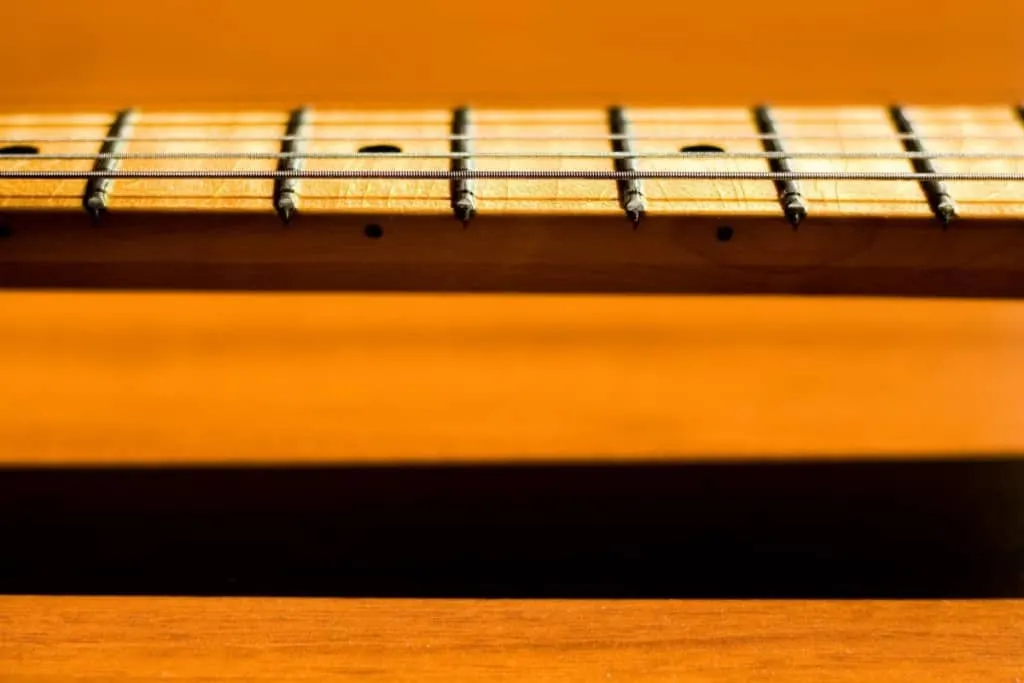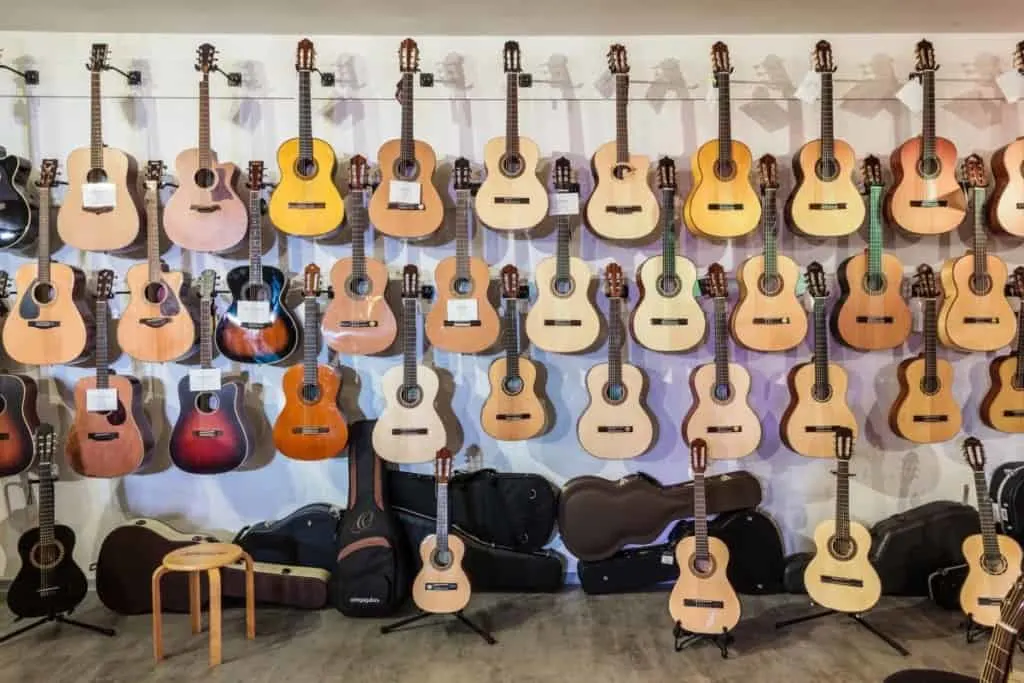A guitar neck is the main reason us guitar players choose to buy or not to buy an instrument. It gives it a certain feel and sound that is what makes us fall in love with it.
Sometimes, an instrument that used to feel like home is suddenly fighting us and you no longer feel comfortable with it. Checking the neck to see if it is straight or not and what to do about it are paramount to the life of any guitar player.
I had to learn the hard way and would like to help you avoid the same (costly) errors I made in this article.
So, how do you check if a guitar neck is straight?
To check if the neck of your guitar is straight or not, you have to check the angle formed by the strings and the fretboard. Ideally, they should be almost parallel to each other. So, grab your guitar, sit the bottom of it on your foot and take a look at the E string while keeping it parallel to your legs. The lines generated by the string and the neck will tell you if the neck is straight or if it is convex or concave. These conditions can be fixed by adjusting the truss rod on your guitar. In fact, the truss rod was invented for that reason.
There are plenty of things to explain about this whole process. You are in luck today because outside is raining, I have a hot cup of coffee next to me and I feel like going in super deep on the subject. Let’s get right on it.
Introduction To Guitar Neck
A guitar neck is not just a piece of lumber; it is the result of mathematical equations that lead us to its current design.
As you might have noticed, your guitar and bass have frets dividing the notes. This hasn’t always been the case. If you take a look at classical instruments in an orchestra, you will quickly realize that they are fretless.
This is the reason, for example, behind the name Precision Bass. When Leo Fender first came up with it, it was the first-ever bass to have frets and he considered that this technologic improvement would give bass players around the world much better accuracy when playing.
Now that we are talking about Fender, he is one of the main believers in neck’s perfect mathematical proportions. This is largely why Fender instruments are almost 100% bolt-on instead of neck-through or set-neck (like Gibson’s). This is not a minor detail, and you’ll understand why in a minute:
· Bolt-on neck – This way of manufacturing attaches the body to the neck with usually four bolts. The idea behind this technology was that necks can go wrong, so Fender customers could just unscrew it and send it back for a replacement instead of taking the whole guitar in for repair.
· Set-neck/Neck-through – Other manufacturers like Gibson, Gretsch, Martin and such use a different technology in which the neck is set into the body with glue or runs all the way to the bottom of the instrument. If something goes wrong with the neck, the whole guitar has to be sent in for service or replacement.
Bear in mind that we are talking about the fifties; they didn’t have computerized technology to measure truss rod adjustment or machines to perfectly manufacture each neck.
Everything was done one-by-one, by hand.
They still knew back then that all necks created do not remain perfect. Every neck needs adjustment, some more than others. We are getting to that right now. Just bear in mind that your guitar will suffer from diverse factors (weather, string tension, temperature, etc.) and will need to have its neck adjusted and serviced.

Most Common Guitar Neck Materials
Most common neck materials in the world are mahogany and maple. These woods have very distinct tonal characteristics but also strength characteristics.
If we consider Leo Fender to be closer to the Henry Ford rather than the Enzo Ferrari of guitars, it is not surprising that the first telecasters had a maple neck.
Maple is an inexpensive, extremely bright and very durable wood. Our friend Leo was no musician, he was actually an engineer. Later on, by 1959 Fender started experimenting, adding a rosewood fretboard to compete against certain jazz brands at the time. The neck on most instruments in the world is made of maple and bolt on because this way it is difficult to alter its natural state and easier to replace.
On the other hand, the brands that use mahogany for their necks face two big issues today: lack of availability and the fact that mahogany is weaker than maple in its constitution.
Gibson is more Ferrari-oriented than Ford-oriented. Even the most affordable models are luxurious instruments next to Fenders. The lack of maple on most of them makes them also more fragile and susceptible to weather nuances. I named Gibson but we can speak about many brands that use this approach to manufacturing (PRS, Gretsch, Martin, etc.)
Which Mistakes To Avoid To Keep A Guitar Neck Straight
This entire introduction was for you to understand which things you can and can’t do with each neck material. Let’s take a look:
Mahogany Guitar Necks
· Strings – You should never leave a mahogany neck without the strings. Because the absence of their weight will not compensate the truss rod, mahogany, which is so easily moldable will twist, bend and turn. There are severe things that can happen in this scenario like ending up with a twisted or warped neck.
· Truss rod – Be careful when adjusting the truss rod on a mahogany neck because tightening the screw too much might lead to the neck cracking open on its back or sides. I have seen this happening in real slim 60s necks like on an SG and believe me it causes pain.
Maple Guitar Necks
· Loud & proud – Since maple necks are loud and proud, the nuances of a bow or concave neck will be more evident. They will cut through the mix and will give you more than a headache. I call maple telecasters “axes” because they cut through the mix. If you have one of these, service it very often, because in the studio we can tell.
· Harder material – Maple being a harder material makes it more resistant to truss rod changes and fixes hence you will have to perform them early in the day if you are playing a gig at night and the guitar neck needs work. It is more stable too, so it will take you through the gig no doubt but will take a while to sink in the changes.
It is a very, very unpleasant surprise to arrive at a venue and feel that your favourite guitar’s neck feels weird and uncomfortable; it makes it harder to concentrate on the playing. Always, always, always leave the guitar case open at the venue with the guitar inside for as long as you can before the show to avoid this.

A Bow Guitar Neck
Ok, now that you know what to do to avoid it in different guitars, let’s take a look at what to do once it has happened. Your guitar neck will go through this many times in its life, so you don’t have to worry too much. It is something that all guitars experience from time to time.
Which are the symptoms?
The symptoms of a bow neck are:
· String height – You will feel that the strings are higher than usual without touching the saddles. For example, I recently went on a trip to a gig, and when I got there and started playing, my guitar was so uncomfortable I had to really push myself to get it to sound right. It had a bow neck, and I didn’t have a wrench, so it turned my performance into a nightmare.
· Buzzing on the ends – When you have string height above what you like, you tend to lower the strings using the saddles. Since the neck has a bow, it will cause string buzzing at the extremes while keeping the middle part still super high. Needless to say, that sanding down the saddle on an acoustic before a performance is not my idea of fun.
How To Check A Guitar Bow Neck?
The first thing about bow necks is that doing the afore-mentioned rest-in-foot technique, the neck shows a bow separating the middle part from the strings while they remain close to the ends.
Another way to check for a bow neck is to use a straight metal ruler and place it on the neck. You will realize immediately if the center part of the neck detaches from the ruler, or it doesn’t. For this to be accurate, you need to sit the guitar on a workbench (AKA a clean table) and take a look at it from the side.
Finally, the last method is to put a capo on the first fret and then with your finger, press on the last playable fret of the guitar. With pressure applied on both ends, you can now check what the height is at the 12th and the 7th fret. If the distance between the fret and the string is too big, then you definitely have a bow neck.
Regardless of the method you use to measure it, to the question is it straight? The answer should be no. But worry not, because we are going straight to what to do to fix it.
Take a look at this video for a simple method of checking your guitar neck
How To Fix a Bow Guitar Neck
A bow neck means that the truss rod is pushing too hard backward.
In order to fix this, we need to do what is called a string relief and loosen the truss rod. Now, this is a very delicate endeavor, and you should only take a quarter of a turn at the time and then check again. Don’t forget that you are tightening and losing an iron screw going all the way through the neck of your guitar. Be gentle.
Symptoms Of A Convex Guitar Neck
A guitar neck can suffer from too much pressure from the truss rod or too little. A convex neck is one of the most annoying things that can happen to your guitar or bass.
You can get through the night and play a gig with a neck that has a bow; it’ll be uncomfortable but doable. If you have a convex neck, you are very likely in big trouble.
Which Are The Symptoms?
It is not easy to describe the feeling you get from a convex neck, but I’ll do my best.
The most noticeable symptom is string buzzing. In fact, if you have a very convex neck, you just can’t play the middle section of the guitar because it will be touching the strings.
You will also feel as if the guitar would be harder when playing. By the term hard I don’t mean difficulty, but you’ll feel that the neck is made of stone or some other super hard material and can even make your hands sore after the gig.
If you try raising the action of the strings from the saddles to get by, you will very likely end up with super high first and last frets and very low middle ground.
How To Check A Guitar Neck Is Straight?
The methods to check your guitar neck and see if it is straight are the same for a concave or convex neck. The difference is in the result. This means that when you sit it on your foot, what you’ll see is that it goes up in the middle as a mountain peak and lowers on the extremes.
The same way, when you put your metal rule on it and if the problem is serious, you will realize that it balances to each side much as if you were on a boat sailing the sea.
Finally, using the capo technique you should have no space in the 7th and 12th frets while the beginning and end will have a generous action to play.
Take a look at this video that goes in-depth on Guitar truss rod adjustment.
How To Fix A Guitar Neck That Isn’t Straight
This is what to do with a convex neck: adjust the truss rod. Instead of loosening it, you have to tighten it up. The action of the truss rod fights string tension and keeps the neck straight. The forces are balanced and hence they add up to zero maintaining your guitar neck perfect and straight.
It is extremely important that you take extra care when doing this.
You can literally break your guitar’s neck when tightening the truss rod. Remember what we said above about the mahogany and maple necks? Well, take 1/8th of a turn on mahogany and 1/4th of a turn on a maple neck and check it again until the problem is solved. In the case of maple necks, let it rest for a couple of hours before checking again because maple is harder.
For mahogany necks, the action will change within half an hour in most cases.

How Often Should You Service Your Guitar Neck?
Guitars and especially every guitar neck should be serviced twice a year: at the beginning of the hot months and at the beginning of the cold months.
Even if you live in a tropical area, you should do it when it’s rainy season since humidity plays a major role in the life of the wood. You can follow these steps here or you can take it to a trusty guitar tech who can also check on fret wear and other issues your instrument might have.
Changing The Guitar String Gauge
Your guitar neck, regardless of if is it straight or not, needs to be adjusted if you change strings gauge.
This is because the gauge of the strings changes the amount of weight pressure they have on the neck itself. This will unbalance the forces and you might end up with a concave or convex neck on your favorite guitar. So, if you decide to change string gauge, you already know what to do.
Changing Guitar Tuning
Tunings have the same effect on a guitar than string gauges: they change the amount of weight the neck has to bear.
Changing tunings will have a less dramatic effect that will definitely demand a smaller fix on your side. Going back to our introduction, maple guitar necks will need minimal to no adjustment in this case while mahogany neck guitars will be more affected.
If you ever wonder why guitar players who play in more than one tuning take several guitars to a gig, here’s the answer: it’s because they have each instrument specifically set up for the string gauge and the tuning to play perfectly.
Weather Report
Finally, weather plays a major role on guitar necks, and you should always bear this in mind unless you’re playing a Travis Bean, aluminum neck guitars, or a carbon fibre Journey guitar. Always check the weather report on your way to a gig and never forget that wrench that can save you from a nightmare night like the one I had!
Final Thoughts On Guitar Necks That Are Not Straight
The guitar neck is the most important part of the guitar in terms of intonation, comfort, and playability. Out of all the guitars I have, I don’t always use the most expensive ones, but the ones that are more comfortable to play. Let’s say it this way: feel beats sound.
Checking a neck to know if it is straight and what to do is something all guitar players should be able to pull off. You should still have the instrument serviced twice a year, but it can be a life-savor knowing how to do it on the spot.
Be extremely careful with mahogany necks and very careful with maple necks. You can always have a word with a professional guitar tech about major issues.
Happy (straight neck) playing!
